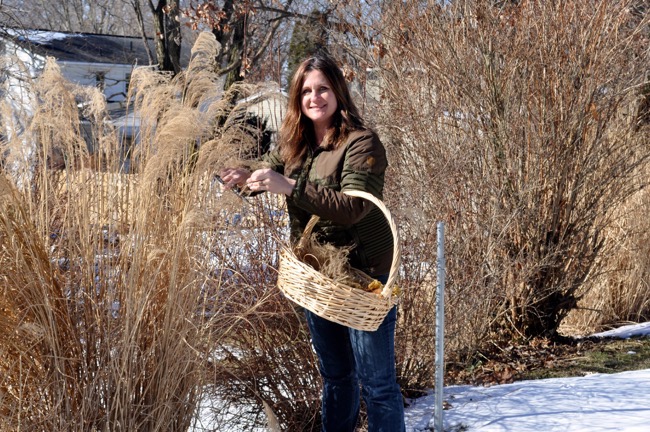Nesting ornaments are a way Michelle Cerino gives Mother Nature a hand.
Usually, I am a very positive person when it comes to weather. Living in Ohio, it’s the only way to survive. This year, though, the large amount of snowfall and below-zero weather has put me over the edge. As I look outside, I see all the poor fluffy robins that have returned, only to experience another snowstorm. After eating all the berries from my holly bush, they hunker down in the branches, seeking some sort of refuge.

I like to give Mother Nature a hand. Whether the birds will make their homes in one of the bird houses hanging in my backyard, or hidden deep inside an arborvitae tree, my feathery friends will begin looking for materials to build nests soon. I can lend them a hand, by making nesting ornaments.
First, I headed out to my yard with a basket and collect all the different natural nesting materials I can find. You can use the following natural materials in combination.
Then, I search in my house for manmade materials. This part is easy; my craft room has nesting materials galore.
Some manmade materials can be harmful to birds and are not recommended to use in nesting ornaments.
Once I collect my materials, I need something to put it all in. Sure, you can drape it on shrubs, stuff it in the crotch of a tree or pile it in sheltered areas, but I like to make nesting ornaments. Plastic, mesh bags that are normally used to contain oranges or onions are perfect for this project. Large pinecones and empty suet holders are another option. I spread all of the supplies on my kitchen island and am ready to begin. If the weather is nice enough, I suggest you do this project outside; it’s a bit messy.
With the bags stretched open, I add a little of each material. I put the stuffing and fluff near the bottom to help keep the materials from falling out. I break some of the twigs into smaller pieces, and cut my fabric and yarn into sizes that will be both safe and manageable to the birds. Once each bag is loosely packed, cinching the top with a string and making a hanging loop is the last step in the process. Voilà!
When standing at my kitchen sink, I can look out into my backyard, so I usually hang the nesting ornaments where I can enjoy watching the birds pick through them. It is important not only to hang the nesting ornaments high enough to protect the birds from any predators, but also to make sure they in an place where the birds will feel safe. I also hang these ornaments under my pergola, among the trumpet vines.
There are no hard and fast rules about putting out nesting ornaments. You might want to do a little research about the types of birds in your area, and what they use to build their nests. Weather plays an important role, too. I watch for the robins to start arriving, and I pay attention to the forecast in my area. It is suggested that nesting ornaments be set out in early spring. I prefer to watch the activity in my own backyard to determine when I will hang my nesting ornaments.
All my hard work pays off when the weather breaks and I can enjoy being outside. With a little snooping, I can usually find some of the nests that were built in my yard. It is a great feeling to see pink Easter grass, fabric and yarn mixed in with all the other debris. I also get to enjoy the beautiful songs of the birds in my yard and watch as the mamas feed their ever-hungry babies.
It is a great feeling to know I gave Mother Nature and my feathered friends some support by making nesting ornaments.
This Retro WON first appeared March 17, 2014.
Michelle Cerino, aka Princess Gunslinger, first entered the firearms industry in 2011 as co-owner, president and trainer at a national training company. She immediately began competing in both 3-Gun and NRA Action Pistol, becoming a sponsored shooter. Michelle is currently a columnist and Managing Editor of Women’s Outdoor News, as well as owner of Pervenio LLC. She also manages social media for Vera Koo and GTM Original. Michelle encourages others to step out of the comforts of home and explore. View all posts by Michelle Cerino
Wonderful craft to make. Thanks for sharing. I liked the part of the pink Easter grass!!!